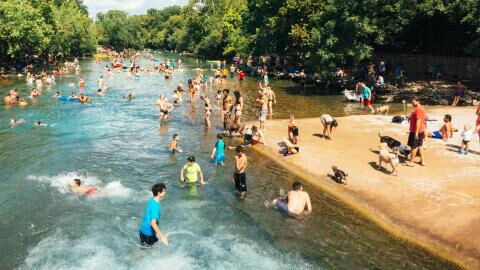Swimming is a great way to beat the summer heat. But swimmers beware: blue-green algae has been spotted in many popular parks and lakes across the UK.
Discover our latest podcast
Despite its name, blue-green ‘algae’ isn’t algae at all. It’s actually a bacterium that multiplies in hot, sunny conditions. While it is completely natural, it is also known to be poisonous to humans and deadly to animals – so don’t be fooled by its hue.
The algae have been identified in Lake Windermere, Apex Park Lake, and Colwick County Park, amongst other popular summer sanctuaries.
Fish found ‘choking’ in Lake Windermere
The Daily Mailreports that Lake Windermere’s fish population are choking to death from the algae. According to BBC, this is because the algae remove oxygen from the water.
Dr. Bryony Chetwynd-Glover of the Aquatic Veterinarian noticed that the fish in the lake were ‘displaying very abnormal, uncoordinated swimming movements at the surface of the water’, which she says indicates neurological damage from blue-green algae.
Dogs who have drank algae-affected water are also at risk of illness and death.
The South Lakeland District Council’s Director warns:
Farmers and pet owners should also prevent livestock and animals coming into contact or drinking the affected water, as it can sometimes prove fatal for animals.
Symptoms of contact in humans include irritation of the eyes, skin rashes, muscle/joint pain, fever, vomiting, and diarrhoea, according to The Mail.

How to spot if your local waters are affected
If you fear your local watering hole is affected, avoid contact. You can tell by observing the colours and patterns present in the water.
Blue-green algae can be murky green, turquoise, and greenish or reddish brown in colour. The surface of affected waters tends to resemble swirling paint.
Bristol veterinarian, Dr. James Greenwood, advises:
If you poke the water with a stick and the stick comes out looking like it’s been in paint, then avoid the water.
While the algae can naturally subside with a change in weather conditions, practice safe swimming and do not enter water that has already been proven poisonous or presents signs of being poisonous.
Read more:
⋙ The Most Beautiful Lake In The World Is Also The Most Deadly
⋙ The lake of horror: skeletons, human remains, Drought reveals macabre finds
⋙ Body Found In The Lake In Front Of Kate Middleton And Prince William’s Home Still Unidentified















